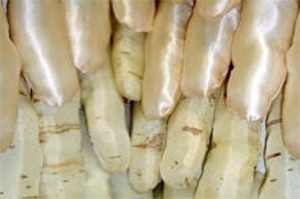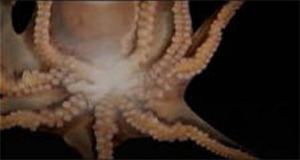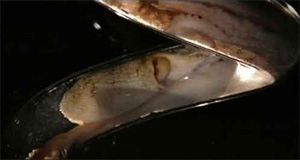Feature: Reviews
Conversations 3: Amy Globus and Cynthia Ona Innis
Granted, my residence in San Francisco hasn’t even hit the one-year mark, but Conversations 3 is the most eloquent gallery show I’ve seen here. Feminine, terrifying, organic, science fiction-y, delicate, an interlacing of two artists in graceful accord with one another—this conversation belongs in another time and place, one that lies on the periphery of a futuristic heaven-meets-hell. There is no clashing in the juxtaposition of Bay Area’s Cynthia Ona Innis and New York-based Amy Globus at San Francisco Arts Commission Gallery’s third installment of the “Conversations” series. The gliding transition from Innis’ exhibit in the front of the gallery to Globus’ curtained-off video installation, Electric Sheep, is like rolling out of a bed and into one of the sensual and somewhat disconcerting dreams composed by the delightfully freakish modernist writer, Djuna Barnes.
Innis is known for her use of satin, but this is the first time she has popped her work out of the two-dimensional realm. Even during her recent residency at MacDowell, she didn’t venture into 3-D. The director and curator of SFACG, Meg Schiffler, recognized that Innis’ aesthetic would complement Electric Sheep, but was pleasantly surprised to see how she really took advantage of the space for her first site-specific exhibition.
Innis transformed stylish bedroom material into pearly “biomorphic growth.” You can find her “pookies,” as she calls them, creeping up walls, piled high in corners, sneaking out of unseen cracks, beckoning you to come roll around, become one with it as it takes over the rest of the building. Like poison ivy or a blushing schoolgirl, this exhibit is a nocuous beauty, innocently offering the soft texture of its skin—needless to say, it pulses in sexual overtone. The weed-like wires jutting out of the walls really played up the unnerving/enticing quality of the exhibit. It appeared as though someone ripped wires out of the wall in a fit of anger. Consequently, the wires dripped and splayed rosy and warm brown tones onto the walls and some of the satin growth clusters. Perhaps they were murdered pookies.
My sinus cavities were extremely congested as I watched the octopi push their way through the curvy tube that connected the two tanks in Electric Sheep. Globus’ exhibit was the analogy I had been looking for all day whenever people inquired about my health. Wrecking Ball by Emmylou Harris and This Mortal Coil’s Song to Siren were weaved together to provide the soundtrack for the sea creatures as they appeared to be in pain and, then, at peace—sometimes simultaneously. Due to the seductive nature of the Harris song and the electrifying shots of tight squeezes and slithery movements—sex and entrapment inevitably came to mind. As did aliens. I assume the position of some of the viewers when I say that the experience of watching the exhibit progressed into a subtle panic. Like, am I that octopus? The video’s hypnotizing effect called attention to the fragility of life. Schiffler calls it “a graphic illustration of humanity.”
Globus illustrated a rare demonstration of humanity when she rescued the two octopi from a food vendor in New York. The frail, tangled creatures were put in a specially constructed saltwater tank transforming her studio into a “beautiful environment.” Then came the realization that octopi were extremely challenging (see: www.advancedaquarist.com/issues/july2003/invert.htm) to keep as pets. Globus’ tenderness towards the eight limbed muses radiated through Electric Sheep and translated an awareness of death—particularly the type of situation where accepting the death of another results in a sense of defeat for the one that survives.
Casting a sideways glance over to Philip K. Dick, everyone’s seen what the guys—namely Robert Crumb, Ridley Scott, Bas Van Koolwijk—have done with his words, but female interpretations/representations of his work are scarce (at least, on the larger scale). In fact, the title Electric Sheep was derived from Dick’s novel Do Androids Dream of Electric Sheep? and the piece was originally exhibited in the Future Noir show at Gorney, Bravin, + Lee in New York. With Globus’ art, the viewer doesn’t have to know anything about Dick in order to be moved by Globus. I find that a lot of Dick-inspired art results in being somewhat an homage or, at least, iconic. Electric Sheep makes a subtle reference to the sci-fi noir aesthetic that PKD has helped create.
Arguably, Globus plays a part in the Goth revival, right alongside Banks Violette. But again, not as explicitly. Whereas Violette plays up the kitsch of twenty-first century Goth (if a skeleton of a chapel found in the audible atmosphere of black metal isn’t kitschy goth, I don’t know what is), Globus merely touches on Goth sensibilities. Her work is dark, but it doesn’t entirely adopt the genre. Her art seems to be driven by her ability to manipulate visual rhythm and layers of sound.
“In the visual sense, it is mostly about sexuality—about darkness and rebirth,” Schiffler commented. Innis’ exhibit intensifies the pheromonic nature of the Conversation while Globus instills a subtle sense of fear. Thus, the two artists identify sex at its best and/or worst: it exposes and stifles.
Regarding the hybrid of squeamish and ultra-feminine art, there have been far too many Meret Oppenheim spin-offs. This is a popular time for apathy and it lends itself to lackluster American artists that are willing to use pastel-puke pigments and lightly reference the ways beautiful can be ugly, but are unable to truly unfurl their imaginations and cast light on the queasy elements of pretty/fragile subject matter. Conversations 3, on the other hand, captured a particular quality of gross in one of the loveliest ways possible.
Conversations 3: Amy Globus and Cynthia Ona Innis is on view at the San Francisco Arts Commission Gallery, 401 Van Ness Avenue, San Francisco, CA 94102, call (415) 554-6080, or visit http://www.sfacgallery.org



